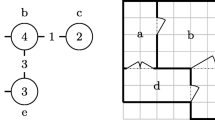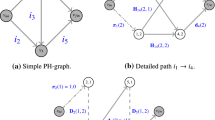Abstract
We consider an agent seeking to obtain an item, potentially available at different locations in a physical environment. The traveling costs between locations are known in advance, but there is only probabilistic knowledge regarding the possible prices of the item at any given location. Given such a setting, the problem is to find a plan that maximizes the probability of acquiring the good while minimizing both travel and purchase costs. Sample applications include agents in search-and-rescue or exploration missions, e.g., a rover on Mars seeking to mine a specific mineral. These probabilistic physical search problems have been previously studied, but we present the first approximation and heuristic algorithms for solving such problems on general graphs. We establish an interesting connection between these problems and classical graph-search problems, which led us to provide the approximation algorithms and hardness of approximation results for our settings. We further suggest several heuristics for practical use, and demonstrate their effectiveness with simulation on a real graph structure.













Similar content being viewed by others
Notes
Although the lengths of edges in the Deadline-TSP problem are integers, and in the Max-Probability problem they are not necessarily so, we note that they do not play any role in the optimization process.
References
Altman, E. (1999). Constrained Markov decision processes (Vol. 7). Boca Raton: CRC Press.
Arora, S., & Karakostas, G. (2000). A $2+\epsilon $ approximation algorithm for the k-MST problem. In Proceedings of the eleventh annual ACM-SIAM symposium on discrete algorithms (SODA-2000) (pp. 754–759).
Åström, K. J. (1965). Optimal control of Markov processes with incomplete state information. Journal of Mathematical Analysis and Applications, 10(1), 174–205.
Aumann, Y., Hazon, N., Kraus, S., & Sarne, D. (2008). Physical search problems applying economic search models. In Proceedings of the twenty-third AAAI conference on artificial intelligence (AAAI-2008) (pp. 9–16).
Balas, E. (1989). The prize collecting traveling salesman problem. Networks, 19, 621–636.
Bansal, N., Blum, A., Chawla, S., & Meyerson, A. (2004). Approximation algorithms for deadline-TSP and vehicle routing with time-windows. In Proceedings of the thirty-sixth annual ACM symposium on theory of computing (STOC-2004) (pp. 166–174).
Bellman, R. (1957). A Markovian decision process. Indiana University Mathematics Journal, 6(4), 679–684.
Bnaya, Z., Felner, A., & Shimony, S. E. (2009). Canadian traveler problem with remote sensing. In Proceedings of the twenty-first international joint conference on artificial intelligence (IJCAI-2009) (pp. 437–442).
Brown, D., Hudack, J., & Banerjee, B. (2015). Algorithms for stochastic physical search on general graphs. In Workshops at the twenty-ninth AAAI conference on artificial intelligence.
Brown, D., Loscalzo, S., & Gemelli, N. (2015). k-agent sufficiency for multiagent stochastic physical search problems. In Proceedings of the 4th international conference on algorithmic decision theory (ADT-15) (pp. 171–186).
Chen, S., Baarslag, T., Zhao, D., Chen, J., & Shen, L. (2016). A polynomial time optimal algorithm for robot–human search under uncertainty. In Proceedings of the twenty-fifth international joint conference on artificial intelligence (IJCAI-2016) (pp. 819–825).
Christensen, P. R. (1986). The spatial distribution of rocks on Mars. ICARUS, 68, 217–238.
Eyerich, P., Keller, T., & Helmert, M. (2010). High-quality policies for the Canadian traveler’s problem. In Proceedings of the twenty-fourth AAAI conference on artificial intelligence (AAAI-2010) (pp. 51–58).
Felner, A., Stern, R., Ben-Yair, A., Kraus, S., & Netanyahu, N. (2004). PHA*: finding the shortest path with A* in an unknown physical environment. Journal of Artificial Intelligence Research, 21, 631–670.
Gambardella, L. M., Taillard, E., & Agazzi, G. (1999). MACS-VRPTW: A multiple ant colony system for vehicle routing problems with time windows. Technical report.
Golombek, M. P., Haldemann, A. F. C., Forsberg-Taylor, N. K., DiMaggio, E. N., Schroeder, R. D., Jakosky, B. M., et al. (2003). Rock size-frequency distributions on mars and implications for mars exploration rover landing safety and operations. Journal of Geophysical Research: Planets, 108(E12), 8086.
Goodhardt, G. J., Ehrenberg, A. S. C., & Chatfield, C. (1984). The Dirichlet: A comprehensive model of buying behaviour. Journal of the Royal Statistical Society. Series A (General), 147(5), 621–655.
Håstad, J. (1999). Clique is hard to approximate within $n^{1 - \epsilon }$. Acta Mathematica, 182(1), 105–142.
Hazon, N., Aumann, Y., & Kraus, S. (2009). Collaborative multi agent physical search with probabilistic knowledge. In Proceedings of the twenty-first international joint conference on artificial intelligence (IJCAI-2009) (pp. 164–167).
Hazon, N., Aumann, Y., Kraus, S., & Sarne, D. (2013). Physical search problems with probabilistic knowledge. Artificial Intelligence, 196, 26–52.
Hudack, J., Gemelli, N., Brown, D., Loscalzo, S., & Oh, J. (2015). Multiobjective optimization for the stochastic physical search problem. In Current approaches in applied artificial intelligence. Lecture Notes in Computer Science (Vol. 9101, pp. 212–221). Springer.
Jeffreys, H. (1946). An invariant form for the prior probability in estimation problems. Proceedings of the Royal Society of London. Series A. Mathematical and Physical Sciences, 186(1007), 453–461.
Kang, S., & Ouyang, Y. (2011). The traveling purchaser problem with stochastic prices: Exact and approximate algorithms. European Journal of Operational Research, 209(3), 265–272.
Kephart, J., & Greenwald, A. (2002). Shopbot economics. Autonomous Agents and Multi-Agent Systems, 5(3), 255–287.
Kotz, S., Balakrishnan, N., & Johnson, N. L. (2004). Continuous multivariate distributions, Volume 1: Models and applications, Chapter 49. Hoboken: Wiley.
McMillan, J., & Rothschild, M. (1994). Search. In R. Aumann & S. Amsterdam (Eds.), Handbook of game theory with economic applications, Chapter 27 (pp. 905–927). Amsterdam: Elsevier.
Meuleau, N., Benazera, E., Brafman, R. I., Hansen, E. A., & Mausam, (2009). A heuristic search approach to planning with continuous resources in stochastic domains. Journal of Artificial Intelligence Research, 34(1), 27.
Nachum, Y., Sarne, D., Das, S., & Shehory, O. (2015). Two-sided search with experts. Autonomous Agents and Multi-Agent Systems, 29(3), 364–401.
Papadimitriou, C., & Vempala, S. (2006). On the approximability of the traveling salesman problem. Combinatorica, 26(1), 101–120.
Papadimitriou, C. H., & Yannakakis, M. (1991). Shortest paths without a map. Theoretical Computer Science, 84(1), 127–150.
Phillips, M., & Likhachev, M. (2011). Planning in domains with cost function dependent actions. In Proceedings of the twenty-fifth AAAI conference on artificial intelligence (AAAI-2011) (pp. 74–80).
Puterman, M. L. (1994). Markov decision processes: Discrete stochastic dynamic programming. Hoboken: Wiley-Interscience.
Ramesh, T. (1981). Traveling purchaser problem. Opsearch, 18, 78–91.
Ravi, R., Sundaram, R., Marathe, M. V., Rosenkrantz, D. J., & Ravi, S. S. (1994). Spanning trees short or small. In Proceedings of the fifth annual ACM-SIAM symposium on discrete algorithms (SODA-1994) (pp. 546–555).
Rochlin, I., Aumann, Y., Sarne, D., & Golosman, L. (2016). Efficiency and fairness in team search with self-interested agents. Autonomous Agents and Multi-Agent Systems, 30(3), 526–552.
Rochlin, I., & Sarne, D. (2015). Constraining information sharing to improve cooperative information gathering. Journal of Artificial Intelligence Research, 54, 437–469.
Rochlin, I., Sarne, D., & Mash, M. (2014). Joint search with self-interested agents and the failure of cooperation enhancers. Artificial Intelligence, 214, 45–65.
Sarne, D., & Kraus, S. (2005). Cooperative exploration in the electronic marketplace. In Proceedings of the twentieth national conference on artificial intelligence (AAAI-2005) (pp. 158–163).
Shapley, L. S. (1953). Stochastic games. PNAS, 39(10), 1095–1100.
Smith, D. E. (2004). Choosing objectives in over-subscription planning. In Proceedings of the fourteenth international conference on automated planning and scheduling (ICAPS-2004) (pp. 393–401).
Smith, T., & Simmons, R. (2004). Heuristic search value iteration for POMDPs. In Proceedings of the 20th conference on uncertainty in artificial intelligence (UAI-2004) (pp. 520–527).
Thompson, D., Wettergreen, D., Foil, G., Furlong, M., & Kiran, A. (2015). Spatio-spectral exploration combining in situ and remote measurements. In Proceedings of the twenty-ninth AAAI conference on artificial intelligence (AAAI-2015) (pp. 3679–3685).
Tsiligirides, T. (1984). Heuristic methods applied to orienteering. Journal of the Operational Research Society, 35(9), 797–809.
Weitzman, M. L. (1979). Optimal search for the best alternative. Econometrica, 47(3), 641–54.
Wettergreen, D., Foil, G., Furlong, M., & Thompson, D. R. (2014). Science autonomy for rover subsurface exploration of the Atacama Desert. AI Magazine, 35(4), 47–60.
Yang, Z., van Osta, J. P., van Veen, B., van Krevelen, R., van Klaveren, R., Stam, A., et al. (2017). Dynamic vehicle routing with time windows in theory and practice. Natural Computing, 16(1), 119–134.
Acknowledgements
This research was partially supported by the Israel Science Foundation (Grant No. 1488/14). The authors would like to thank Max Kleb, Gilad Tsmadia, Sefi Erlich and Elyasaf Schwer for the implementation of the heuristics and the simulation environment.
Author information
Authors and Affiliations
Corresponding author
Ethics declarations
Conflict of interest
The authors declare that they have no conflict of interest.
Additional information
Publisher's Note
Springer Nature remains neutral with regard to jurisdictional claims in published maps and institutional affiliations.
Appendix
Appendix
For analyzing the hardness of approximation of the Min-Budget problem, we were tempted to investigate the dual of the Deadline-TSP problem, which we term Min-Length-Deadline-TSP, as follows:
Definition 3
Given a weighted graph \(G=(V,E)\) on n nodes, with a start node a, a prize function \(\pi :V\rightarrow Z^+\cup \{0\}\), deadlines \(D:V\rightarrow Z^+\cup \{0\}\), a length function \(\ell :E\rightarrow Z^+\cup \{0\}\), and a prize quota q, find a path starting at a that minimizes the total length while collecting a total prize of at least q, where a path starting at a collects the prize \(\pi (v)\) at node v if it reaches v before D(v).
That is, in this problem there is a known quota for the prize, and the target function is finding a minimum length path that meets this prize quota. We show a strong hardness of approximation result for the Min-Length-Deadline-TSP.
Theorem 5
The Min-Length-Deadline-TSP problem is hard to approximate within any constant ratio.
Proof
We reduce the decision version of the TSP problem with triangle inequality to the Min-Length-Deadline-TSP problem. In the decision version of the TSP problem we are given a parameter W and a weighted graph, and we need to find if there is a TSP path with weight at most W. We define an instance of the Min-Length-Deadline-TSP with the same graph, where the deadlines of all nodes equal W, all nodes have a unit prize, and \(q=n\) (the prize quota equals the number of nodes). Any feasible solution to the Min-Length-Deadline-TSP problem, even an approximated one, must traverse all nodes before their deadline, which implies a feasible TSP path with a weight at most W. This cannot be achieved in polynomial time if \(P\ne NP\). \(\square \)
Rights and permissions
About this article
Cite this article
Hazon, N., Gonen, M. Probabilistic physical search on general graphs: approximations and heuristics. Auton Agent Multi-Agent Syst 34, 1 (2020). https://doi.org/10.1007/s10458-019-09423-z
Published:
DOI: https://doi.org/10.1007/s10458-019-09423-z




